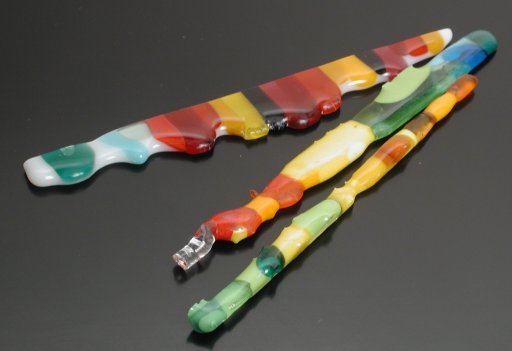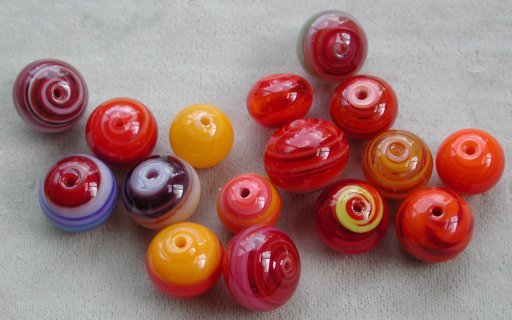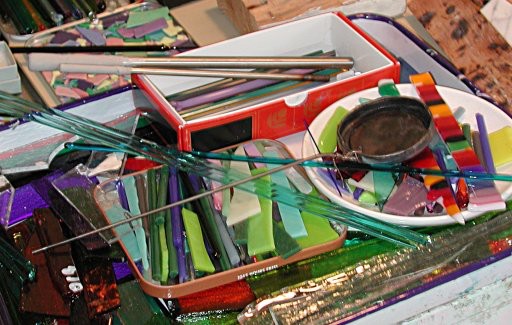There are three techniques I use to make “stripey” beads:
- stripe a rod with color and make beads
- wodge together chunks of glass and make beads
- fuse multiple colors into strip or sheet and use that to make beads
I'm going to discuss the newest method (3), here. It comes in 3a and 3b flavors:

The strip on the left is fused bullseye; the two on the right are morretti/effetre ends fused in a ‘rod pod’; photographed 3apr2005, coolpix 990
3a is prefused sheet; 3b is prefused “rods”. Bullseye, if you hadn't heard, is going for the flameworking market in a big way, and has started churning out a lot of their basic colors in rod form, as well as many new, yummy colors. (And some colors which look much cooler in sheet than they do in rod, ’cuz the sheet cools and therefore strikes unevenly...1234 opaque purple/blue is a good example of this effect.)
This means I was left with a lot ‘sizzle sticks’, sheet cut in 1/4-3/8” wide strips, their old method of making sheet (semi)acceptable to lampworkers, which I don't like working with nearly as much as the rods, which are easier to rotate. (Exception: tape two sizzle sticks together, and you've got a rod square in cross-section, ideal for for doing twisties on the fly. But that's a subset of technique #1...)
I'm also trying to dip my toe into the fusing thing, with the idea of some day doing pate de verre. A friend kindly allowed me to set up a good size sheet in her bathtub kiln, and so I fused the old sizzle sticks onto white. The plan was to then strip crosswise, shift the stripes a little, and refuse. But the edges were too messy, so I saved them for beadmaking. Not to mention the fusing cycle ran too fast, which resulted in huge bubbles and lumps, but again, that's a problem for another day:)

The bullseye beads tend to be on the left; effetre on the right—oopsie, the lowermost orange and red bead to the right was a twistie on the fly bead, a variation on the #1 technique I'm supposed to discuss in another post. Photographed 20apr2005, coolpix990
The other variation I attempted comes from a different friend's effetre ‘end’ collection. I piled a bunch of these into a bullseye rodpod, and they got fused in the same firing as the sheet. I thought by pre-fusing them, there would be fewer problems with explodo glass, and by and large I was correct.
As the picture shows, the techniques don't show a great deal of difference in the beads: the bullseye strip tended to yield simpler color combinations, because it generally requires about 1” to 1-1/4” (25–30mm) standard glass rod to make a small bead—but since these were thick with dribbles I sometimes only got in one or two colors as opposed to the typical three-four I shoot for and would've gotten if I'd used quarter-inch (8mm) wide strip. The one-to-one ratio of white to colored (opaque or transparent, I used both) glass seemed to work well. Bullseye yields softer, less strongly delineated stripes as a rule than does effetre.
Like method 2, the wodging one, I found I had less control over the colors than with striping, but if I restricted the fuse to 3–4 colors, I expect I could fix that. In fact, I imagine with patience I could get remarkably consistant results with sheet in pre-fused colors and patterns.
Technical issues: I had to grind kiln wash off the rod-pod glass some; and in both cases I mounted the color on plain rods to make rotating the glass easier. (You can see where one of my mounting rods cracked off the middle strip in the picture. —Lost one of my prettiest beads because I mistakenly mounted the bullseye on an effetre clear, so of course it cracked. It really is important to pay attention when multiple glasses on the table: in this case I simply forgot the bullseye was a different glass, because I grouped the pre-fused glass together by technique, instead of by coe. Bad.) Even with the sticks fused and annealed I still preheated in a kiln and I still had one nasty break while working.
As is so often the case, things didn't quite work out as I intended. The rod-pod method works well enough, but I think wodging is faster and more consistant for using scrap, especially factoring in the time to clean off the release. The bullseye sheet, on the other hand, was fired on shelf paper, and so simple water washing removed all the residue. I just made beads out of the no-good edges for a lark, so of course it's the technique I've concluded is worth following: I believe it's more suited to production than striping or wodging.

Some day I'll write a real post, but in the meantime this is the tool I load my scrap in to preheat. The handle is a bent 3/32 mandrel, and the lid is about 2” (50cm) across.
16 soda lime stripeys, 10–13mm diameter made with pre-fused strips. March 2005.
Unless otherwise noted, text, image and objects depicted therein copyright 1996--present sylvus tarn.
Sylvus Tarn